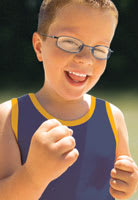feature
It's All Fun & Games...
Until your patient can't see out of his
or her eyewear. A guide to keeping the practical side of frame fitting in the selection
process
By Amy Spiezio
|
|
|
Issues like durable hinges and Rx-friendly frame depths don't have to impede frame selection. Shown: Face a Face style Nueva |
Frames are the fun part of eyewear—it's a chance to lighten up the process and add fashion flair to the dispensing experience. As a result, it's easy to let some of the basics of frame fitting slide. While fashion-first frame selection might seem like a way of enhancing the optical experience for your patients, it may end up backfiring.
If the frames don't work with prescriptions, don't meet the patients' physical needs, or don't stand up to their lifestyle demands, you will end up with unhappy clients. The following is a refresher course in frame considerations beyond style.
PRESCRIPTION PROPER
The first question from every dispenser should be: What is your prescription? A look at the prescription can be followed by a simple rundown of the ideal eyewear configurations to work with the lenses needed.
|
|
|
|
|
|
| Top to bottom: Seniors benefit from colorful frames such as Lightec Colortips styles 6038 and 6260 from Morel Cottet and Joan Collins style JC9657 from New York Eye/Hart Specialties; winning kids frames have flex. Shown: Aspex Easy Twist style ET 791 |
Multifocal lenses. Progressive wearers may need a deeper B for their eyewear to provide space for the full channel. Short corridor lenses help keep more options available to this market, but the most PAL-friendly frames need to fit a lens with a minimum recommended fitting height of 14mm.
High corrections. Thanks to high-index lenses, this is another portion of eyewear users with more options than ever. However, if the patient opts to go with something besides a polycarbonate, Trivex, or high-index lens, advise against semi-rimless, rimless, and thin wire models for cosmetic and fitting purposes. A chunky plastic frame can hide thick lenses.
Myopes should avoid frames with severe edges, as they show edge thickness. If a myope insists on a geometric shape, try a soft diamond.
Round, panto, oval, P3, and soft square frames, are perfect for a strong Rx because the frame PD is close to the patient PD. This keeps the need for lens decentration to a minimum and controls edge thickness.
Plastic frames may be a better choice for this market segment for best visual performance as well. Ensuring a correct vertex distance— the distance between the patient's cornea and the back of the lens—is particularly important for those with corrections greater than +/-5. Metal frames with adjustable nosepads are more likely to be incorrectly measured during the fitting process.
GENERATIONS
While nobody wants to judge a book by its cover, there are certain age-appropriate frame considerations for young and old.
Kids: Safety is the top consideration for this demographic. Kids need frame styles that can take abuse in everyday wear as well as extracurricular activities. Spring hin-ges and flexible materials help endure rough treatment, and cable-maker temple tips keep eyewear in place.
Infants and toddlers usually have an undeveloped bridge. Plastic frames with low bridges and no back pads or metal frames with silicone unifit bridges will keep frames from sliding down the nose. Even tweens and teens have bridge-fitting challenges. While their faces are the right size for adult eyewear, be aware of the potential need for adjustable nosepads.
Seniors: Smaller can be better. From a cosmetic standpoint, smaller eyewear gives seniors an updated look, and there's less to magnify wrinkles around the eyes. An upswept frame shape can act as a non-surgical face lift. Pastels, bold colors, or shiny silver frames can ramp up the senior color factor.
Screwless and lightweight, titanium three-piece rimless mounts are practical for seniors. The light frames don't irritate thinning skin on the nosebridge and durable frames won't need constant adjustments.
LIFESTYLE
Figuring lifestyle into the frame selection process ensures the patient is getting what is needed and opens the door for potential multiple sales. Consider the following.
|
|
|
Durable eyewear works for working people. Shown: Kenmark's Wolverine style Plateau |
Occupational eyewear. The duty to warn shouldn't end with a safe lens choice. The safest lens in the world is not appropriate protection when teamed with a frame that wasn't designed for safety. There are lines out there specifically created to meet this need.
Durability. Whether it's a senior prone to falling, a baby boomer who falls asleep with her glasses on, or a teenager who keeps his glasses at the bottom of his backpack, many need tough glasses. These folks are ideal candidates for flexible metal styles for knocking around and a second pair that is more style focused.
A PAL's Friend
The emerging presbyope market of tech- savvy baby boomers isn't likely to take no for an answer when it comes to getting what they want in eyewear. To ease their transition into PALs, share the following frame fitting advice.
Diamond shape. A small, softened diamond is fashionable and provides more depth than many small shapes.
|
|
|
A-2 Premium Collection style SG 105 from Hilco is a safe bet. |
Consider natural bridge. A patient with a naturally low bridge is a good candidate for the small frame/PAL pairing, because he gets more depth than someone whose frames sit high on his face.
Adjust nosepads. Adjust nosepads to lower the bridge, which provides more depth.
Avoid nasal cutouts. Shapes with deep nasal cutouts, such as aviators, cut in to the reading portion of the lens.
Mostly metals. Strong metals, particularly titanium, are a great choice for progressives because they hold their shape well.
Rimless options. Tension mounts are good for rimless frames, which are growing in popularity, since they hold their shape well.









